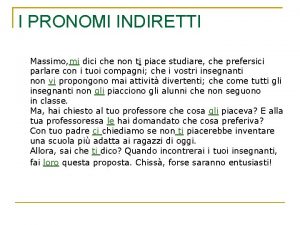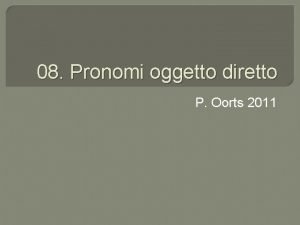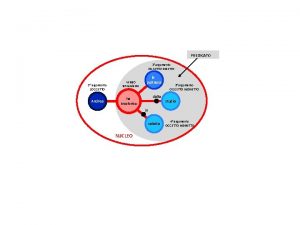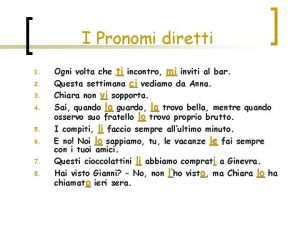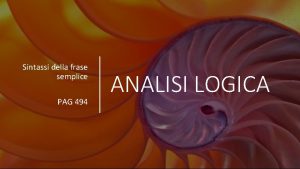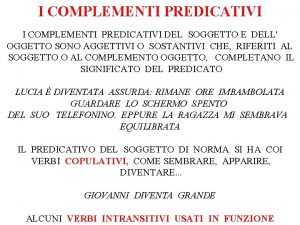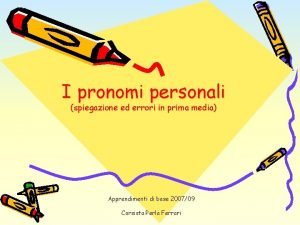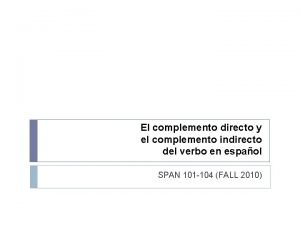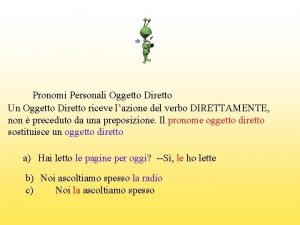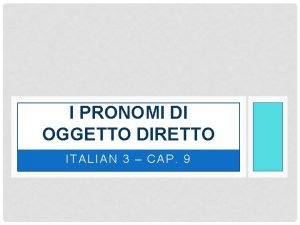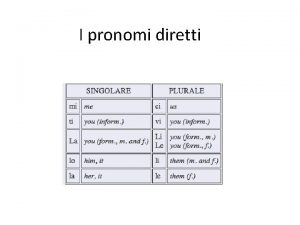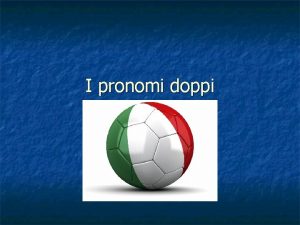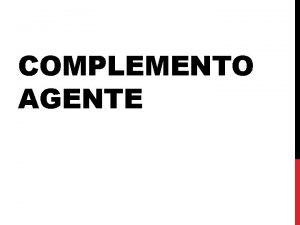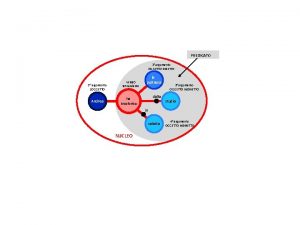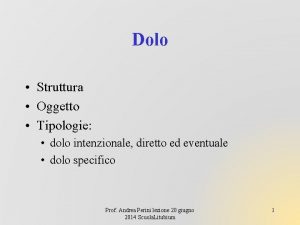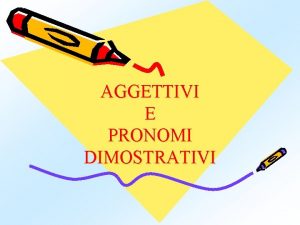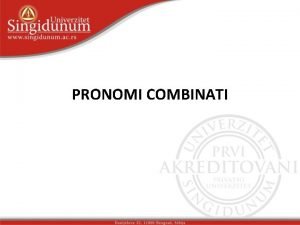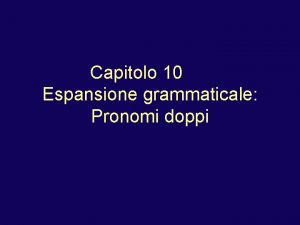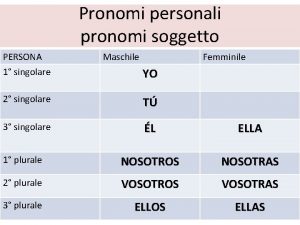I pronomi complemento oggetto diretto What is a


















- Slides: 18

I pronomi complemento oggetto diretto

What is a direct object? • a direct object is what receives the action of the verb • I buy shoes every week. – What do I buy? shoes, the direct object • I read the Alligator every day. – What do I read? the Alligator, the direct object

What is a direct object pronoun? • a direct object pronoun REPLACES the direct object in a sentence… • I buy shoes every week. • I buy them every week. • I read the Alligator every day. • I read it every day.

• In Italian the direct object pronoun must agree in number and gender with the direct object. • look on page 157… • what pronoun would replace the following nouns? – Compro la carne. – Cucino il pesce. – Invito Erica alla festa.

Placement • Direct object pronouns, like all pronouns in Italian, can only go in one of two places… 1. in front of the first conjugated verb or 2. attached to the infinitive

• I eat the cake. • I eat it. • Mangio la torta. • La mangio. • Erica buys strawberries at Publix. • Erica buys them at Publix. • Erica compra le fragole a Publix. • Erica le compra a Publix.

• There are three steps: 1. identify the direct object 2. choose a pronoun (that agrees in number and gender) 3. place the pronoun (either directly before the conjugated verb or attached to the infinitive)

Assieme • Ripasso, p. 158 A

• LO and LA normally elide with verbs that begin with a vowel • LI and LE never elide • • lo assagio l’assagio la aiuto l’aiuto le assagio li aiuto

In gruppi… • p. 158, B

• In Italian the following verbs take direct objects even though they don’t in English, p. 158 • cercare • ascoltare • guardare • aspettare

In gruppi… • p. 159, C • p. 159, D • Assieme: • p. 159, E – Inventare degli indovinelli come nell’esercizio E

CI, p. 159 • CI replaces nouns or phrases referring to a place, usually introduced by the prepositions a, in, da, su. • CI can also be used with the verbs pensare a and credere a/in.

• Vai a classe oggi? – Non ci vado. • Puoi andare in centro con Erica? – Sì, ci posso andare. • Pensi al tuo ragazzo? – Ci penso spesso. • Credi nella magia? – Non ci credo.

• CI can go in one of two places: 1. in front of the first conjugated verb or 2. attached to the infinitive

assieme. . • p. 160, A • p. 161, B • p. 161, C

Facciamo una festa Chi fa…? Chi prende…? la torta la birra le patate il vino gli spaghetti il pane l’insalata i pomodori la macedonia le melanzane le bruschette il formaggio le lasagne le bistecche la pizza le fragole Chi pulisce…? il salotto il bagno la cucina la sala il tavolo le sedie il pavimento

Abbiamo fatto una festa Chi ha fatto? Chi ha preso? Chi ha pulito? la torta le patate gli spaghetti l’insalata la macedonia le bruschette le lasagne la pizza la birra il vino il pane i pomodori le melanzane il formaggio le bistecche le fragole il salotto il bagno la cucina la sala il tavolo le sedie il pavimento
 Pronomi dati
Pronomi dati Pronomi diretti
Pronomi diretti Pronomi oggetto diretto
Pronomi oggetto diretto L'imperativo in italiano
L'imperativo in italiano Argomento oggetto indiretto
Argomento oggetto indiretto L'imperativo indiretto
L'imperativo indiretto Verbi indiretti
Verbi indiretti Pronomi diretti di 3 persona
Pronomi diretti di 3 persona Predicativo dell'oggetto
Predicativo dell'oggetto Complemento di termine
Complemento di termine Predicativo dell'oggetto
Predicativo dell'oggetto Predicato
Predicato I complementi oggetti
I complementi oggetti Quaero peto
Quaero peto Pronomi personali prima media
Pronomi personali prima media Pronomi personali complemento forma tonica
Pronomi personali complemento forma tonica Complemento indirecto español
Complemento indirecto español Pronomes pessoais complemento direto
Pronomes pessoais complemento direto Discurso indirecto
Discurso indirecto

